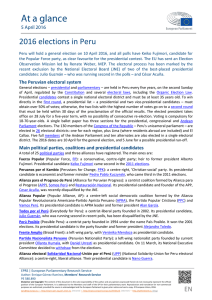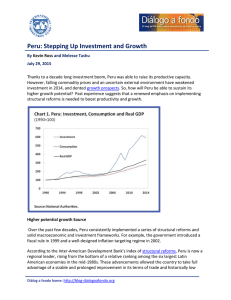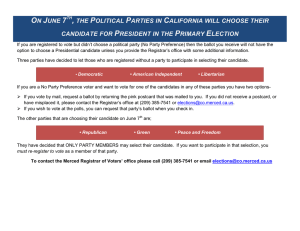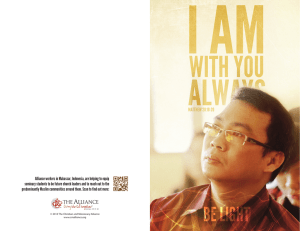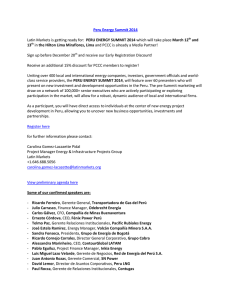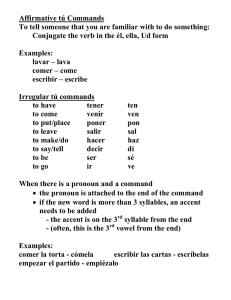elections - European Parliament
Anuncio
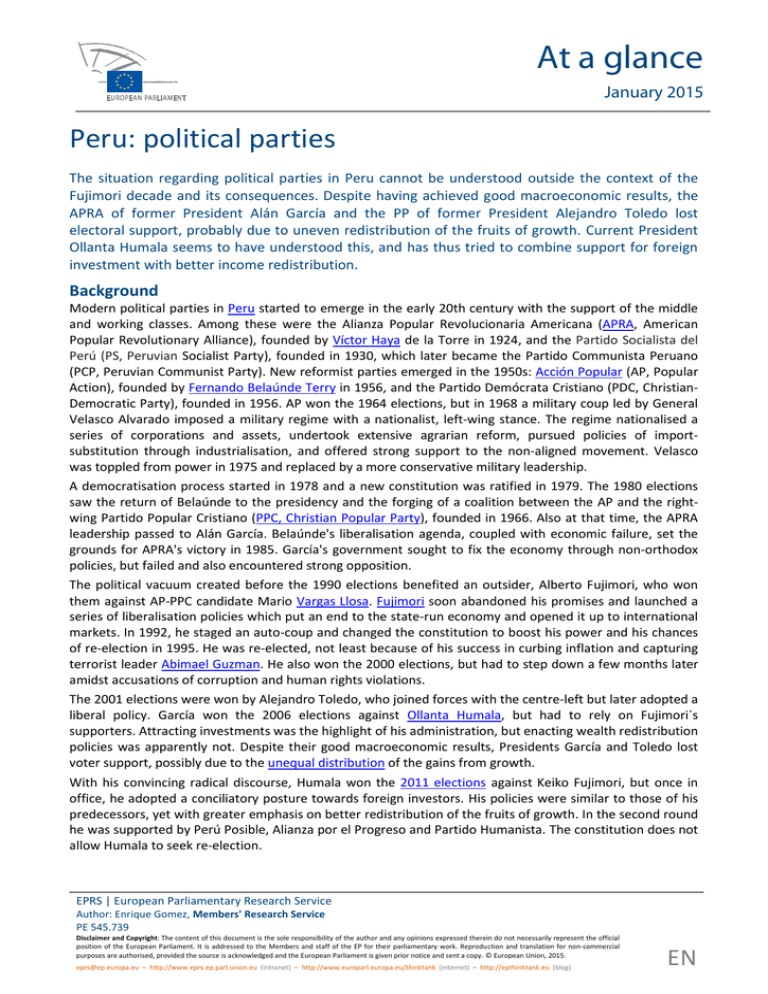
At a glance January 2015 Peru: political parties The situation regarding political parties in Peru cannot be understood outside the context of the Fujimori decade and its consequences. Despite having achieved good macroeconomic results, the APRA of former President Alán García and the PP of former President Alejandro Toledo lost electoral support, probably due to uneven redistribution of the fruits of growth. Current President Ollanta Humala seems to have understood this, and has thus tried to combine support for foreign investment with better income redistribution. Background Modern political parties in Peru started to emerge in the early 20th century with the support of the middle and working classes. Among these were the Alianza Popular Revolucionaria Americana (APRA, American Popular Revolutionary Alliance), founded by Víctor Haya de la Torre in 1924, and the Partido Socialista del Perú (PS, Peruvian Socialist Party), founded in 1930, which later became the Partido Communista Peruano (PCP, Peruvian Communist Party). New reformist parties emerged in the 1950s: Acción Popular (AP, Popular Action), founded by Fernando Belaúnde Terry in 1956, and the Partido Demócrata Cristiano (PDC, ChristianDemocratic Party), founded in 1956. AP won the 1964 elections, but in 1968 a military coup led by General Velasco Alvarado imposed a military regime with a nationalist, left-wing stance. The regime nationalised a series of corporations and assets, undertook extensive agrarian reform, pursued policies of importsubstitution through industrialisation, and offered strong support to the non-aligned movement. Velasco was toppled from power in 1975 and replaced by a more conservative military leadership. A democratisation process started in 1978 and a new constitution was ratified in 1979. The 1980 elections saw the return of Belaúnde to the presidency and the forging of a coalition between the AP and the rightwing Partido Popular Cristiano (PPC, Christian Popular Party), founded in 1966. Also at that time, the APRA leadership passed to Alán García. Belaúnde's liberalisation agenda, coupled with economic failure, set the grounds for APRA's victory in 1985. García's government sought to fix the economy through non-orthodox policies, but failed and also encountered strong opposition. The political vacuum created before the 1990 elections benefited an outsider, Alberto Fujimori, who won them against AP-PPC candidate Mario Vargas Llosa. Fujimori soon abandoned his promises and launched a series of liberalisation policies which put an end to the state-run economy and opened it up to international markets. In 1992, he staged an auto-coup and changed the constitution to boost his power and his chances of re-election in 1995. He was re-elected, not least because of his success in curbing inflation and capturing terrorist leader Abimael Guzman. He also won the 2000 elections, but had to step down a few months later amidst accusations of corruption and human rights violations. The 2001 elections were won by Alejandro Toledo, who joined forces with the centre-left but later adopted a liberal policy. García won the 2006 elections against Ollanta Humala, but had to rely on Fujimori´s supporters. Attracting investments was the highlight of his administration, but enacting wealth redistribution policies was apparently not. Despite their good macroeconomic results, Presidents García and Toledo lost voter support, possibly due to the unequal distribution of the gains from growth. With his convincing radical discourse, Humala won the 2011 elections against Keiko Fujimori, but once in office, he adopted a conciliatory posture towards foreign investors. His policies were similar to those of his predecessors, yet with greater emphasis on better redistribution of the fruits of growth. In the second round he was supported by Perú Posible, Alianza por el Progreso and Partido Humanista. The constitution does not allow Humala to seek re-election. EPRS | European Parliamentary Research Service Author: Enrique Gomez, Members' Research Service PE 545.739 Disclaimer and Copyright: The content of this document is the sole responsibility of the author and any opinions expressed therein do not necessarily represent the official position of the European Parliament. It is addressed to the Members and staff of the EP for their parliamentary work. Reproduction and translation for non-commercial purposes are authorised, provided the source is acknowledged and the European Parliament is given prior notice and sent a copy. © European Union, 2015. [email protected] – http://www.eprs.ep.parl.union.eu (intranet) – http://www.europarl.europa.eu/thinktank (internet) – http://epthinktank.eu (blog) EN EPRS Peru: political parties Situation in Congress Following the 2011 elections, a number of political parties and 2011 Parliamentary Elections alliances are represented in the unicameral Congress. Peru Wins (47) Gana Perú (Peru Wins) alliance, led by the Partido Nacionalista Peruano (PNP, Peruvian Nationalist Party) of Ollanta Humala. It is Force 2011 (37) a left-wing nationalist alliance formed in 2010 with the Perú Posible (21) Communist PCP, the Socialist PS, the Partido Socialista All. G. Change (12) Revolucionario, (PSR, Socialist Revolutionary Party), the Nat. Solidarity (9) Movimiento Politico Voz Socialista (MPVS, Political Movement APRA (4) Socialist Voice), and some regional movements. Since the alliance Sources: JNE, Elecciones Generales 2011 lacks a congressional majority, to pass legislation it has had to seek the support of Perú Posible, which is not unconditional. The alliance seems likely to continue supporting policies in favour of foreign investment and is trying to promote a model of economic growth with social inclusion. The Fuerza (Force) 2011 alliance, now Fuerza Popular Perú (FP, Popular Force Peru) is led by Keiko Fujimori. A conservative, centre-right party, it is heir to former President Alberto Fujimori. Despite his imprisonment for fraud, he is widely credited with having overcome hyperinflation and terrorism in the 1990s and having paved the way for Peru's strong economic growth. With 37 MPs, it is the second force in Parliament. Perú Posible alliance is led by Alejandro Toledo. This centrist party, founded in 1994 under the name País Posible, won the 2001 elections and is currently the third force in Congress, with 21 seats. Alianza por el Gran Cambio (Alliance for Great Change) is led by the Alianza para el Progreso (APP, Alliance for Progress). A centre-right, social-Christian alliance formed around Pedro Pablo Kuczynski, a brilliant economist and former minister in various governments, as presidential candidate. It was initially formed by the Partido Popular Cristiano, the Alianza para el Progreso, the Restauración Nacional (National Restoration Party) and the Partido Humanista Peruano (Peruvian Humanist Party), and 2011 Presidential elections, obtained 12 seats in Congress. In August 2013, some members left the 2nd round alliance, which had changed its name to PPC-APP in the meantime. 52% 51% Alianza Solidaridad Nacional (National Solidarity Alliance) is led by Luis Castañeda, former mayor of Lima. This political alliance, led by the National 50% Solidarity Party, obtained nine seats in Congress. 49% Alianza Popular Revolucionaria Americana – Partido Aprista Peruano (APRA), 48% led by Alán García, is the oldest party in Peru and has a centre-left, social47% democratic platform. It has a well-developed organisation, and has tended to Humala Fujimori align with FP. It currently holds four seats in Congress. Sources: JNE, Elecciones Generales 2011 Links with other parties outside Peru Although in the 2006 elections Humala was closer to President Hugo Chávez of Venezuela, now his PNP is more aligned with Brazil's ruling Partido dos Trabalhadores (Workers Party) and Uruguay's Frente Amplio (Broad Front). Peru's Partido Popular Cristiano belongs to the Centrist Democrat International (alongside Germany's CDU, Spain's Partido Popular (Popular Party) and Brazil's Democratas). APRA belongs to the Socialist International (alongside Germany's SPD, Spain's PSOE and Brazil's Partido Democrático Trabalhista (Democratic Labour Party)). The EU sent an observation mission to the second round of the 2011 presidential elections in Peru. The EU observers rated the process as good or satisfactory in most polling stations, and as highly transparent. Political dialogue with the EU is based on the 1996 Rome Declaration and was strengthened and institutionalised through the Agreement on Political Dialogue and Cooperation between the EU and the Andean Community, still pending ratification. There is also a bilateral consultation mechanism between the EU and Peru. In its 2012 Resolution on the Trade Agreement with Colombia and Peru, the European Parliament 'endorsed all the legislative and non-legislative measures taken by Peru and Colombia to fight poverty (…) to safeguard children's and women rights, (…) to follow the path of sustainable development as the only viable future for our planet, to promote indigenous peoples rights, broader dialogue and citizen's participation in the legislative process.' Members' Research Service Page 2 of 2
